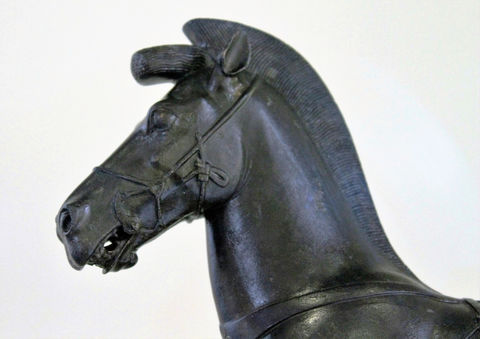Ascot on the Alpheios
Horse races in Olympia

(Diesen Text auf Deutsch lesen)
‘The horse’s capacity to be tamed and bred turned the swift horse into a domestic animal that could be steered by man. In a word, as a vector in animal form, the horse became a political animal’ (Raulff 2017). While horses have now gone ‘into semi-retirement with a part-time job as a recreational item, a mode of therapy, a status symbol, and a source of pastoral support for female puberty’ (Raulff 2017), in previous centuries they were an essential component of everyday life. In ancient Greece too, equids played an important role in myth and warfare, and served as transport animals or as an expensive investment for the elites. For the sanctuary of Zeus in Olympia they also performed various essential tasks. Fast transport of persons or news, for example, would not have been possible without them. The horse races at the Olympic Games, however, surely constituted their most conspicuous activity there.
The ancient Olympic Games attracted participants and spectators from the entire Greek world. The hippic contests had a particular impact, as they offered an excellent occasion for public display to those whose social and financial position allowed them the possession of race horses. This required a huge effort both logistically and financially, as it entailed transporting the competing horses and carriages to Olympia as well as further equipment, spare parts and an experienced crew. Furthermore, a basic supply of the animals’ habitual fodder is likely to have been taken along too, in order to make it easier for the horses to get used to the new environment. Such transport took place over land and sea, depending on the origins of a team’s owner, and necessitated a great deal of planning and expenditure. Upon arrival in Olympia suitable facilities were needed to allow the animals to acclimate and to make up lost training time. Trainers, animals and equipment thus needed to arrive in the sanctuary well before the start of the games to be in top condition for the race.
These efforts were rewarded by the great public interest in the hippic contests, which is evidenced by the gradual expansion of the contest programme over time. ‘A status eclipsing that of all other contests’ (Mallwitz 1972, 66) was held by the race with the four-horse chariot, as was already the case in the Homeric epics. Since 680 B.C., races were held in the Olympic hippodrome, which according to Pausanias lay south of the stadion and stretched more than half a kilometre to the east. He gives a detailed description of the complex including several buildings, such as the sophisticated starting place behind the stoa of Agnaptos (Paus. VI 20.10–14). He also mentions the turning-posts and the altar of Taraxippos, the horse-scarer. The plausible expectation of finding the remains of these structures led to the surveying and examining of the southeastern part of the sanctuary, but in spite of all the efforts, no remains of any construction that can be connected to the horse races have been found (Senff 2013).
The east pediment of the temple of Zeus at Olympia also shows the preparations for a horse race. It shows a version of the Olympic foundation myth which identifies a context between Pelops and Oinomaos as the origin of the games. Pelops is said to have founded the Olympic Games to atone for his winning the race by unfair means. Pausanias (V 20.8) mentions earthworks in his own time during which fragments of horse-bits and curb-chains were found near Oinomaos’ pillar. Votive gifts in bronze and terracotta, fragments of statues or parts of carriages are just some of the material remains that inform modern archaeologists of the presence of horses in Zeus’ sanctuary.
Sandra Zipprich, 22. September 2017
Sandra Zipprich is a Ph.D. student at the University of Marburg and a member of the Olympia project of the German Archaeological Institute (DAI), Athens Department.
Further reading on this topic:
Pausanias, Guide to Greece, vol. 2, Southern Greece, translated by Peter Levi, London 1979.
S. Bell – C. Willekes, Horse Racing and Chariot Racing, in: G. L. Campbell (ed.), The Oxford Handbook of Animals in Classical Thought and Life, Oxford 2014, 478–490.
A. Mallwitz, Olympia und seine Bauten, München 1972.
U. Raulff, Farewell to the Horse: The Final Century of Our Relationship, London 2017.
R. Senff, Olympia. Das Hippodrom, 2013, <https://www.dainst.org/projekt/-/project-display/33190> (26.07.2017).